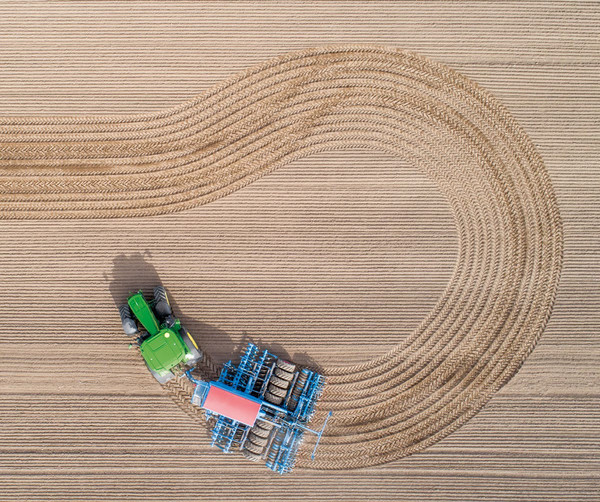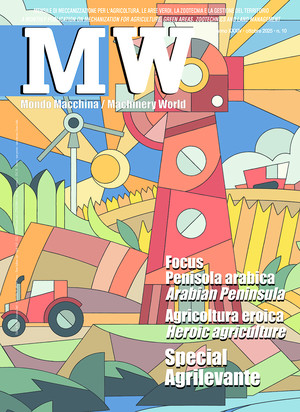
Satellite guidance systems for agricultural machinery
Precision Agriculture makes it possible to do "the right thing, at the right time, in the right place" by employing machines equipped with appropriate technological systems for field operations. Of particular importance among these are satellite guidance devices
Implementing the concept of precision farming involves, as a basic requirement, making agricultural equipment travel predefined trajectories. To achieve this, drivers must simultaneously control both the equipment's work functions and its direction of travel. This task requires a high expenditure of psycho-physical energy, which is particularly burdensome when distributing production inputs that often require the travel of parallel and equidistant trajectories to minimize overlapping and untreated portions of soil and/or crop. Precise guidance is particularly needed with plant protection products, the more so when the doses sprayed are at the limit of efficacy or, conversely, toxicity. In such operational situations, manual guidance is strongly conditioned by the environmental situations at the time of intervention. If visibility is not optimal (due to fog and/or working in dark conditions), the accuracy with which trajectories are followed significantly worsens since it is more difficult to locate any reference points, particularly if they are placed at a great distance. Therefore, no matter how skilled the operator is, it is impossible to avoid overlaps between passes with manual guidance, especially if high-width machinery is used. Assuming an experienced person driving, at best conditions, the minimum degree of overlap is estimated to be around 10%, with peaks up to 20-25% if dealing with small and irregularly shaped plots. This results in increased work time, increased fuel consumption, and wasted distributed product, resulting in heavy impacts on agronomic, environmental, and economic aspects at the farm level. It is in this application context that satellite guidance systems successfully fit. They make it possible to achieve greater accuracy of work, savings in time and inputs (diesel, plant protection products, fertilizers, etc.), less operator fatigue and thus less risk of accidents. Moreover, there is the possibility of employing technically trained but limited experienced operators, even for the most demanding work.
To date, two different solutions are on the market for increasing technological and performance complexity: Assisted and semi-automatic guidance.
The assisted guide acts passively, allowing the operator to correct the trajectory of the tractor or self-propelled machine by manually operating the steering wheel, following the instructions provided by an optoelectronic interface and/or a graphical interface installed on an onboard display. The first system typically consists of a led bar: The operator is instructed to correct the tractor in the correct trajectory by sequentially turning on the various diodes. Operation requires the central green LED to remain lit when the default trajectory is met (with minimal tolerance). If the vehicle deviates from it, the right or left red LEDs would illuminate in a number proportional to the amount of waste that occurred.
The graphical interface, on the other hand, shows the operator a virtual representation of the machine and the instantaneous trajectory it is going through, thus facilitating course corrections both along the passes and in the turning phases. Regardless, since the operator performs course correction, it is not advisable to employ high-accuracy satellite receivers (the reflexes and manual dexterity of the tractor driver cannot guarantee centimeter-tolerant guidance if an RTK satellite system is used). Therefore, for this type of satellite guidance, single frequency satellite receivers with correction or EGNOS, or via private satellite, are sufficient to obtain a decimetric level error.
Semi-automatic driving requires an onboard computer normally connected to a dual-frequency satellite receiver with RTK correction, as well as sensors and actuators that allow automatic trajectory correction, limiting operator intervention to end-of-field turns. In this case, the interface is a graphical touchscreen display that facilitates interaction with the system. Depending on the device used, semi-automatic steering differs into systems that drive the steering wheel and, conversely, devices that act directly on the steering's hydraulic circuit. In the first case, a high-torque electric motor works either directly on the steering wheel chainring using a small pinion or is connected to the steering column. In both cases, the device automatically makes the necessary trajectory corrections by turning the steering wheel in place of the operator, who only has to make the turning maneuver at the end of the pass. Since it is a small electric actuator, this solution has the advantage that it can be moved and installed in a few minutes on several tractors.
In the second case, the actuation is due to a proportional solenoid valve inserted on the steering hydraulic circuit and driven by the onboard computer. The latter, receiving position data from the satellite receiver, calculates the deviation from the ideal trajectory and adjusts the extension of the hydraulic cylinder that controls the steering wheels accordingly. The result is immediate and very effective trajectory correction. It should be remembered, however, that the insertion of an after-market solenoid valve on the hydraulic steering circuit causes the tractor to lose its approval for use on public roads; therefore, to avoid penalties, it will be necessary to either re-approve the vehicle or use it only within the farm perimeter. To overcome this problem, more and more tractor manufacturers are equipping new models with a solenoid valve as standard. In any case, both types of semi-automatic driving are well suited for operations requiring a high level of precision so as to allow the driver to focus mainly on the machine's work, no longer having the burden of continuously correcting the path of travel.
Given the higher level of technology and the need for RTK-corrected satellite receivers, semi-automatic driving systems are significantly more expensive than those for simple assisted guidance; however, the quality of work is considerably higher. To facilitate the choice of the type of satellite guidance, it is useful to refer to the various configurations of satellite receivers and position correction, depending on the main field operations.
A recent technical innovation that has appeared on the market makes it possible to automate even the turning maneuver, making any operation even more precise. This brings us closer to substantially automatic field guidance while always having, also for safety reasons, the operator on board the vehicle ready to intervene in emergencies.
It should also be mentioned that semi-automatic guidance systems not only properly guide the farm machinery along predefined trajectories but also provide additional operational advantages. For example, using a dual antenna system with RTK correction allows operation even at very low working speeds (as low as 0.04 km/h) without losing positioning accuracy. This configuration is ideal for low-speed transplants or mid- and/or high-speed weeding, particularly in high-slope conditions. Automatic adjustment of plant protection and fertilizer distribution machine sections, which is especially useful at headlands or field closures, also has as its technological heart a semi-automatic guidance system that is integrated, of course, with appropriate sensors and actuators on the equipment.
Finally, satellite guidance can contribute to the most efficient farm management since, for each operation, it is possible to store on the onboard computer the date of execution, duration, route taken, area worked, opening trajectories of each plot, etc., allowing a correct, albeit simplified, compilation of the farm's information system.








